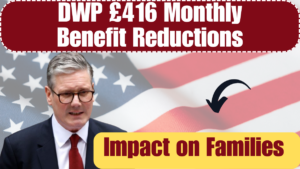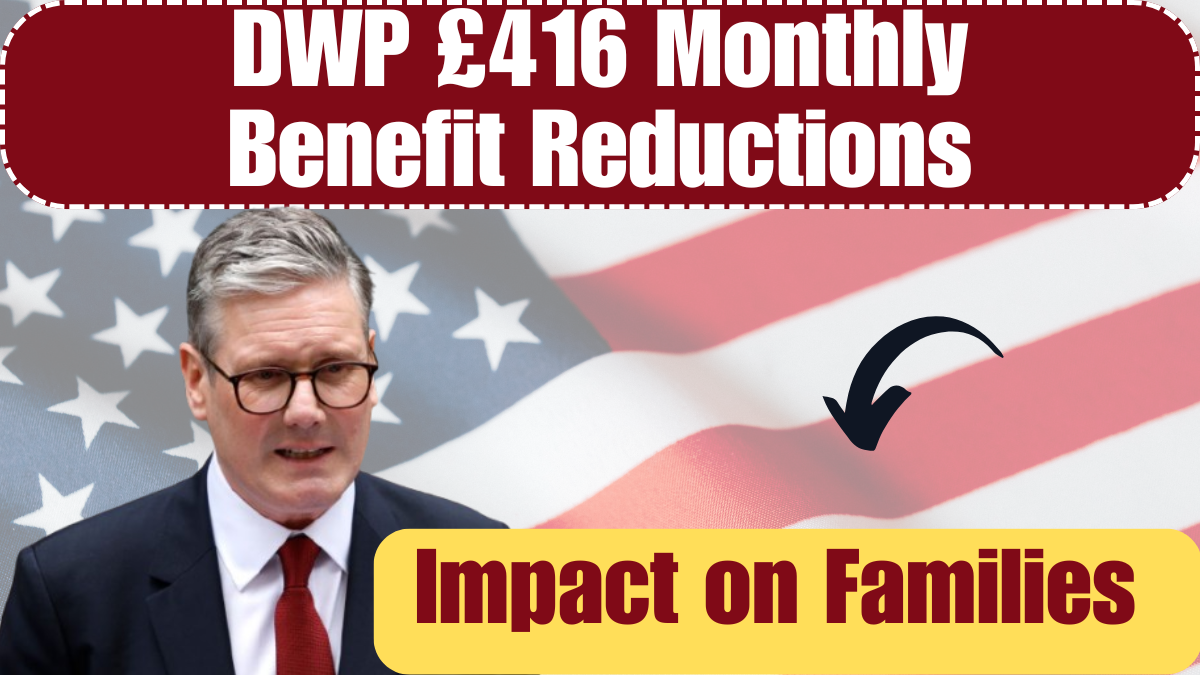Thousands of households across the UK are facing notable financial adjustments in April 2025 as the Department for Work and Pensions (DWP) implements new benefit reductions. Under this revised welfare strategy, families could see their monthly support reduced by as much as £416. While the government presents these reforms as necessary for controlling public expenditure and promoting employment, critics argue that the changes could place additional strain on already struggling individuals.
This article explains the policy, outlines the affected benefits, and helps families understand what to expect and how to prepare.

What Does the £416 Monthly Benefit Reduction Mean?
The updated benefit policy introduces significant changes that impact various income support schemes. The maximum monthly cut per household is estimated to reach up to £416. This change is part of a long-term welfare reform plan that will be gradually rolled out over the next few years.
The primary government benefits affected include:
-
Universal Credit
-
Employment and Support Allowance (ESA)
-
Housing Benefits
The new plan is expected to influence over 450,000 households, particularly those depending on disability-related support or housing assistance.
Core Details of the DWP Reduction Plan
| Element | Information |
|---|---|
| Maximum Reduction | Up to £416 per month per household |
| Affected Families | Estimated 450,000 households |
| Main Benefits Impacted | Universal Credit, ESA, Housing Benefits |
| Timeline for Implementation | Phased in until 2028, with annual reviews |
| Exemptions | Severe disabilities and specific circumstances |
| Support Resources | Available via official DWP portals and local advisors |
These changes are being introduced gradually, meaning affected households may not feel the full impact immediately but should still plan ahead.
Why Has the Government Initiated These Cuts?
The government has outlined three key reasons behind the introduction of this benefit reduction strategy:
-
Public Spending Control
Rising welfare costs have led to a sharp increase in expenditure, from £52 billion to £65 billion over five years. These cuts are part of a larger plan to manage fiscal responsibility and optimize allocation of public funds. -
Incentivizing Employment
A core goal of the new policy is to motivate individuals who are able to work to seek employment. The government believes that reducing dependence on state benefits will encourage more people to rejoin the workforce. -
Reducing Fraud and Administrative Errors
Misuse of the welfare system through fraudulent claims and administrative oversights has contributed to significant financial losses. These reforms are expected to improve accuracy and ensure that benefits are provided only to those who genuinely qualify.
Despite these justifications, many advocacy groups argue that the policy disproportionately affects vulnerable individuals, especially those with health conditions and limited job opportunities.
Who Is Likely to Be Most Affected?
The benefit reductions do not apply uniformly to all recipients. Instead, they focus on particular demographics that rely heavily on support. Those most likely to be impacted include:
-
Universal Credit recipients in the Work Capability Assessment group
-
People relying on ESA due to medical or disability reasons
-
Single-parent households managing basic expenses
-
Older adults nearing retirement but not yet eligible for pensions
-
Renters who depend on Housing Benefits to maintain housing stability
These groups often face the greatest barriers to employment and financial independence, making the reduction in monthly income more difficult to absorb.
Preparing for the Impact: What Can Families Do?
While the reductions are being introduced gradually, families should take steps now to manage the potential loss of income. Here are a few suggestions to navigate this transitional period:
-
Review Eligibility – Check if your household qualifies for any exemptions based on health, disability, or other unique conditions.
-
Explore Local Aid – Seek assistance from local councils or charitable organizations that offer food, housing, or financial support.
-
Contact DWP Advisors – Schedule a discussion with DWP support staff to understand how the changes apply to your personal situation.
-
Plan Budget Adjustments – Begin restructuring your monthly expenses in anticipation of reduced support.
-
Check for Additional Benefits – Explore childcare credits, tax reliefs, or pension credit eligibility to supplement lost income.
By taking proactive measures, families can reduce the financial burden and plan for long-term stability.
Conclusion
The DWP’s £416 monthly benefit reduction plan is one of the most significant welfare adjustments in recent years. While it is framed as an effort to reduce national spending and promote employment, its real-world effects will be deeply felt by thousands of families across the UK. Understanding how these changes work, who they affect, and what steps to take can make a meaningful difference.
The phased nature of the policy offers some breathing room, but it also signals the need for careful financial planning and awareness. For those impacted, staying informed and reaching out to local or governmental support services will be essential in navigating the months ahead.
Frequently Asked Questions
When will the £416 benefit reductions take full effect?
The reductions are being phased in gradually until 2028, with annual evaluations. Some families may experience the changes sooner than others, depending on their benefit type.
Which benefits are affected by the policy?
The primary benefits impacted include Universal Credit, Employment and Support Allowance (ESA), and Housing Benefits.
Is everyone receiving benefits affected by this reduction?
No, certain individuals with severe disabilities or exceptional circumstances may qualify for exemptions from the cuts.
Why is the government reducing these benefits now?
The stated reasons include controlling public spending, encouraging employment, and minimizing fraud and errors within the welfare system.
Click here to know more.
